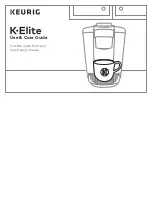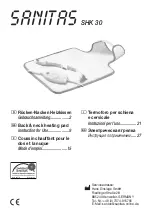
Important Safeguards and Warnings
READ AND FOLLOW THE WARNINGS AND INSTALLATION INSTRUCTIONS PROVIDED IN THIS MANUAL.
FAILURE TO DO SO COULD RESULT IN ANY OF THE FOLLOWING: CABLE FAILURE, IMPROPER SYSTEM
OPERATION, PROPERTY DAMAGE, BODILY INJURY OR DEATH. THE WARRANTY IS INVALID IF THE
WARNINGS AND SPECIFIC INSTRUCTIONS ARE NOT FOLLOWED.
1. The instruction manual follows North American standard building construction conventions.
2. An electrical inspector may be required before, during and after the installation. It is recommended to
contact your local building department BEFORE beginning the installation.
3. DO NOT energize the cable before installation as it will cause overheating or damage to the cable.
4. Connect cables to rated voltage only. Be sure to size for conductors properly to carry the rated amperage.
5. This product is approved for indoor use only. Minimum installation temperature is 40 F .
6. Use only copper supply wires. Be sure to size for conductors properly to carry the rated amperage.
7. DO NOT cut the blue heating cable or attempt to alter the length in any way. The black cold lead can
be shortened, but only at the end of the cable where the power leads are exposed. DO NOT cut at the splice
between the cold lead (black wire) and the heating wire. (blue wire)
8. DO NOT install heating cable under any type of floor that requires nailing.
9. Ground fault protection (GFCI) is required when installed in wet environments such as a bathroom. Consult the
local electrical and building authority to determine and additional requirements in your area.
10. If the GFCI trips during normal conditions and cannot be reset, consult an electrician for service. NEVER
attempt to bypass or disable the GFCI system.
11. When installing cable in shower areas, the cable must be installed under the waterproofing membrane to
keep the cables dry.
12. DO NOT drill, nail of cut into any floors that have heating cable installed underneath. This could result in
contact with live electrical wires causing electrical shock.
13. DO NOT use staples, nails or similar fasteners directly on the cable. Use only factory the factory strapping
system to attach cable. The use of any other fastening method will void the warranty.
14. Use a smooth plastic trowel only. NEVER bang or drop a tool on the cable. Care should be taken not to
nick or gouge cable.
15. DO NOT install the heating cable under a cabinet or other built-in. This will cause the cable to overheat.
16. DO NOT install the heating cable (blue wire) inside a wall. Only the cold lead can go into a wall stud.
17. DO NOT extend the heating cable beyond the room or area that it originates.
18. DO NOT attempt to repair damaged cable without a factory splice kit.
19. DO NOT overlap heating cables. Dangerous overheating will occur.
20. DO NOT allow the cold lead or thermostat sensor to cross or overlap the heating cable.
21. All cables must be completely embedded into a cement based mortar including the cold lead, cold lead
splice, heating cable, heating cable tail splice and thermostat sensor with the wire lead.
22. DO NOT bend the cable at sharp right angles. Always maintain a minimum 1” radius.
23. Maintain at least a minimum of 2” between heating cables.
24. Test and record the cable resistance at least 4 times during installation.
25. After installation of the cable, the installer must inspect and remove damaged or defective cables
before they are covered or concealed.
26. The installer should mark the appropriate circuit breaker reference label indicating which branch circuit
supplies the circuits to those electric space heating cables.
27. These products are to be installed in accordance with ANSI/NFPA 70, National Electrical Code (NEC) and
CAN/CSA-C22.1, Canadian Electrical Code, Part I (CEC).
28. Only UL Listed conduit, fittings, and/or other components are to be used.
29. Products are listed for installations with a maximum thermal resistance value of R-1 for floor covering that
can be placed on top of your product
King Electrical Floor Heating Cable Installation Manual
4
WARNING: ELECTRIC SHOCK AND FIRE HAZARD!




































